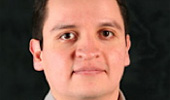The Condensed Matter & Surface Sciences Colloquium Series presents Dr. Salvador Barraza-Lopez on “Understanding the Properties of Conformal Two-Dimensional Materials from Atomic Displacements” on Thursday, Oct. 2, at 4:10 p.m. in Walter Lecture Hall 245.
Barraza-Lopez is Assistant Professor of Physics at the University of Arkansas-Fayetteville.
Abstract: Two-dimensional materials (graphene, hexagonal boron nitride, single layer transition metal dichalcogenides, and so on) can be easily deformed to adapt (or in mathematical language, to conform) to arbitrary shapes, thus establishing a direct connection between the geometry of a two-dimensional manifold and its materials properties.
This connection is traditionally understood in terms of differential geometry and continuum mechanics. In this description one looses track of atomistic information, as a discrete atomistic mesh is replaced by a featureless and chemically-inert continuum.
Given that two-dimensional materials are atomistic (this is, not continuum) membranes, our group set to study how to couple material properties to atomic positions –bypassing differential geometry/continuum mechanics descriptions altogether to understand shape and function of two-dimensional materials. In this talk, I will discuss the present state of affairs which will be exemplified with graphene, which renders a lattice gauge theory in two spatial dimensions.
The discrete framework to study two-dimensional materials being developed in Arkansas reduces to the well-known continuum models in the limit of small deformations from a planar shape.
Upcoming Colloquia
Oct. 30, Dr. Parthapratim Biswas, Glidden Visiting Professor from the University of Southern Mississippi, on “Hydrogen Microstructure in Amorphous Silicon.”
Abstract: In this talk, I will address the problem of designing complex material as an inverse problem, and show that many aspects of structural and electronic properties of amorphous materials can be understood better from an inverse or a hybrid point of view. In particular, I will discuss how the distribution of hydrogen in amorphous silicon can be obtained by inverting experimental nuclear magnetic resonance spectra in conjunction with first-principles density-functional calculations. New results concerning two important aspects of hydrogen microstructure, such as voids and molecular hydrogen, will be presented in this talk.




















Comments